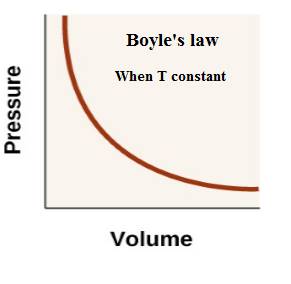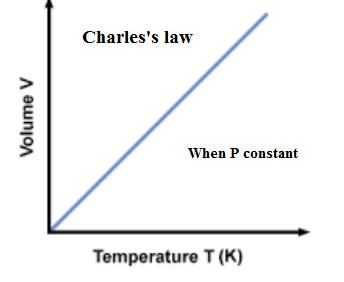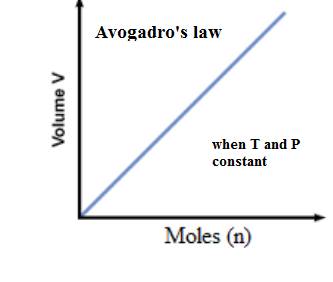
(a)
Interpretation:
The quantity which remains constant in Boyle’s law, Charles’s law and
Concept Introduction:
Boyle’s law, Charles’s law and Avogadro’s law describe the relationship between two variables keeping one variable constant.
(a)
Answer to Problem 5RQ
In Boyle’s law, temperature remains constant.
In Charles’s law, Pressure remains constant.
In
Explanation of Solution
Boyle’s law: The pressure of a gas is inversely proportional to the volume of the gas at constant temperature.
The relationship between pressure and volume of a gas is expressed as-
Charles’s law: The volume of a given amount of gas is proportional to its temperature (in K) of the gas at constant pressure.
The relationship between volume of a gas and temperature is expressed as-
The relationship between the volume of a gas and the number of moles present in the gas is expressed as-
So,
| Boyle’s law | Charles’s law | Avogadro’s law | |
| Constants | Temperature | Pressure | Pressure and temperature |
(b)
Interpretation:
The quantities which are variables in Boyle’s law, Charles’s law and
Concept Introduction:
Boyle’s law, Charles’s law and Avogadro’s law describe the relationship between two variables keeping one variable constant.
(b)
Answer to Problem 5RQ
In Boyle’s law, Pressure and volume are variables.
In Charles’s law, Volume and temperature are variables.
In
| Boyle’s law | Charles’s law | Avogadro’s law | |
| Variables | Pressure and volume | Volume and temperature | Volume and number of moles |
Explanation of Solution
Boyle’s law: The pressure of a gas is inversely proportional to the volume of the gas at constant temperature.
The relationship between pressure and volume of a gas is expressed as-
Charles’s law: The volume of a given amount of gas is proportional to its temperature (in K) of the gas at constant pressure.
The relationship between volume of a gas and temperature is expressed as-
The relationship between the volume of a gas and the number of moles present in the gas is expressed as-
| Boyle’s law | Charles’s law | Avogadro’s law | |
| Variables | Pressure and volume | Volume and temperature | Volume and number of moles |
(c)
Interpretation:
The graph of Boyle’s law, Charles’s law and
Concept Introduction:
Boyle’s law, Charles’s law and Avogadro’s law describe the relationship between two variables keeping one variable constant.
(c)
Answer to Problem 5RQ

Explanation of Solution
Boyle’s law: The pressure of a gas is inversely proportional to the volume of the gas at constant temperature.
The relationship between pressure and volume of a gas is expressed as-

Charles’s law: The volume of a given amount of gas is proportional to its temperature (in K) of the gas at constant pressure.
The relationship between volume of a gas and temperature is expressed as-

The relationship between the volume of a gas and the number of moles present in the gas is expressed as-

(d)
Interpretation:
Boyle’s law, Charles’s law and
Concept Introduction:
Boyle’s law, Charles’s law and Avogadro’s law describe the relationship between two variables keeping one variable constant.
(d)
Answer to Problem 5RQ
Volume of a gas is directly proportional to its temperature and the amount of gas.
Charles’s law showed that the volume of a gas is directly proportional to its temperature (in K) at constant pressure.
Explanation of Solution
Boyle’s law:
Charles’s law:
So, volume of a gas is directly proportional to its temperature and the amount of gas. Charles’s law showed that the volume of a gas is directly proportional to its temperature (in K) at constant pressure and Avogadro’s law showed that the volume of a given amount of gas is directly related to the number of moles at constant temperature and pressure.
Chapter 13 Solutions
World of Chemistry
- A certain half-reaction has a standard reduction potential Ered +1.26 V. An engineer proposes using this half-reaction at the anode of a galvanic cell that must provide at least 1.10 V of electrical power. The cell will operate under standard conditions. Note for advanced students: assume the engineer requires this half-reaction to happen at the anode of the cell. Is there a minimum standard reduction potential that the half-reaction used at the cathode of this cell can have? If so, check the "yes" box and calculate the minimum. Round your answer to 2 decimal places. If there is no lower limit, check the "no" box.. Is there a maximum standard reduction potential that the half-reaction used at the cathode of this cell can have? If so, check the "yes" box and calculate the maximum. Round your answer to 2 decimal places. If there is no upper limit, check the "no" box. yes, there is a minimum. 1 red Πν no minimum Oyes, there is a maximum. 0 E red Dv By using the information in the ALEKS…arrow_forwardIn statistical thermodynamics, check the hcv following equality: ß Aɛ = KTarrow_forwardPlease correct answer and don't used hand raitingarrow_forward
- Please correct answer and don't used hand raitingarrow_forward(11pts total) Consider the arrows pointing at three different carbon-carbon bonds in the molecule depicted below. Bond B Bond A Bond C a. (2pts) Which bond between A-C is weakest? Which is strongest? Place answers in appropriate boxes. Weakest Bond Strongest Bond b. (4pts) Consider the relative stability of all cleavage products that form when bonds A, B, AND C are homolytically cleaved/broken. Hint: cleavage products of bonds A, B, and C are all carbon radicals. i. Which ONE cleavage product is the most stable? A condensed or bond line representation is fine. ii. Which ONE cleavage product is the least stable? A condensed or bond line representation is fine. c. (5pts) Use principles discussed in lecture, supported by relevant structures, to succinctly explain the why your part b (i) radical is more stable than your part b(ii) radical. Written explanation can be no more than one-two succinct sentence(s)!arrow_forward. 3°C with TH 12. (10pts total) Provide the major product for each reaction depicted below. If no reaction occurs write NR. Assume heat dissipation is carefully controlled in the fluorine reaction. 3H 24 total (30) 24 21 2h • 6H total ● 8H total 34 래 Br2 hv major product will be most Substituted 12 hv Br NR I too weak of a participate in P-1 F₂ hv Statistically most favored product will be major = most subst = thermo favored hydrogen atom abstractor to LL Farrow_forward
- Five chemistry project topic that does not involve practicalarrow_forwardPlease correct answer and don't used hand raitingarrow_forwardQ2. Consider the hydrogenation of ethylene C2H4 + H2 = C2H6 The heats of combustion and molar entropies for the three gases at 298 K are given by: C2H4 C2H6 H2 AH comb/kJ mol¹ -1395 -1550 -243 Sº / J K¹ mol-1 220.7 230.4 131.1 The average heat capacity change, ACP, for the reaction over the temperature range 298-1000 K is 10.9 J K¹ mol¹. Using these data, determine: (a) the standard enthalpy change at 800 K (b) the standard entropy change at 800 K (c) the equilibrium constant at 800 K.arrow_forward
- 13. (11pts total) Consider the arrows pointing at three different carbon-carbon bonds in the molecule depicted below. Bond B Bond A Bond C a. (2pts) Which bond between A-C is weakest? Which is strongest? Place answers in appropriate boxes. Weakest Bond Strongest Bond b. (4pts) Consider the relative stability of all cleavage products that form when bonds A, B, AND C are homolytically cleaved/broken. Hint: cleavage products of bonds A, B, and C are all carbon radicals. i. Which ONE cleavage product is the most stable? A condensed or bond line representation is fine. ii. Which ONE cleavage product is the least stable? A condensed or bond line representation is fine. c. (5pts) Use principles discussed in lecture, supported by relevant structures, to succinctly explain the why your part b (i) radical is more stable than your part b(ii) radical. Written explanation can be no more than one-two succinct sentence(s)! Googlearrow_forwardPrint Last Name, First Name Initial Statifically more chances to abstract one of these 6H 11. (10pts total) Consider the radical chlorination of 1,3-diethylcyclohexane depicted below. 4 4th total • 6H total 래 • 4H total 21 total ZH 2H Statistical H < 3° C-H weakest - product abstraction here bund leads to thermo favored a) (6pts) How many unique mono-chlorinated products can be formed and what are the structures for the thermodynamically and statistically favored products? Product 6 Number of Unique Mono-Chlorinated Products Thermodynamically Favored Product Statistically Favored Product b) (4pts) Draw the arrow pushing mechanism for the FIRST propagation step (p-1) for the formation of the thermodynamically favored product. Only draw the p-1 step. You do not need to include lone pairs of electrons. No enthalpy calculation necessary H H-Cl Waterfoxarrow_forward10. (5pts) Provide the complete arrow pushing mechanism for the chemical transformation → depicted below Use proper curved arrow notation that explicitly illustrates all bonds being broken, and all bonds formed in the transformation. Also, be sure to include all lone pairs and formal charges on all atoms involved in the flow of electrons. CH3O II HA H CH3O-H H ①arrow_forward
 ChemistryChemistryISBN:9781305957404Author:Steven S. Zumdahl, Susan A. Zumdahl, Donald J. DeCostePublisher:Cengage Learning
ChemistryChemistryISBN:9781305957404Author:Steven S. Zumdahl, Susan A. Zumdahl, Donald J. DeCostePublisher:Cengage Learning ChemistryChemistryISBN:9781259911156Author:Raymond Chang Dr., Jason Overby ProfessorPublisher:McGraw-Hill Education
ChemistryChemistryISBN:9781259911156Author:Raymond Chang Dr., Jason Overby ProfessorPublisher:McGraw-Hill Education Principles of Instrumental AnalysisChemistryISBN:9781305577213Author:Douglas A. Skoog, F. James Holler, Stanley R. CrouchPublisher:Cengage Learning
Principles of Instrumental AnalysisChemistryISBN:9781305577213Author:Douglas A. Skoog, F. James Holler, Stanley R. CrouchPublisher:Cengage Learning Organic ChemistryChemistryISBN:9780078021558Author:Janice Gorzynski Smith Dr.Publisher:McGraw-Hill Education
Organic ChemistryChemistryISBN:9780078021558Author:Janice Gorzynski Smith Dr.Publisher:McGraw-Hill Education Chemistry: Principles and ReactionsChemistryISBN:9781305079373Author:William L. Masterton, Cecile N. HurleyPublisher:Cengage Learning
Chemistry: Principles and ReactionsChemistryISBN:9781305079373Author:William L. Masterton, Cecile N. HurleyPublisher:Cengage Learning Elementary Principles of Chemical Processes, Bind...ChemistryISBN:9781118431221Author:Richard M. Felder, Ronald W. Rousseau, Lisa G. BullardPublisher:WILEY
Elementary Principles of Chemical Processes, Bind...ChemistryISBN:9781118431221Author:Richard M. Felder, Ronald W. Rousseau, Lisa G. BullardPublisher:WILEY





